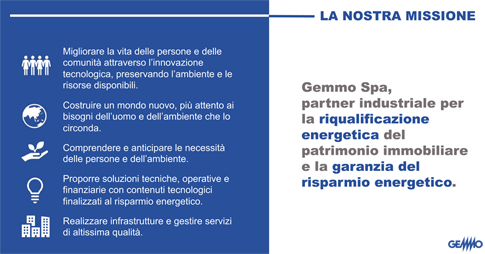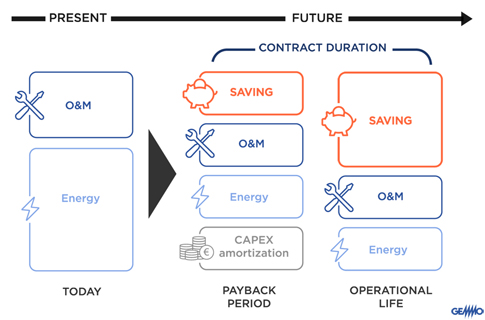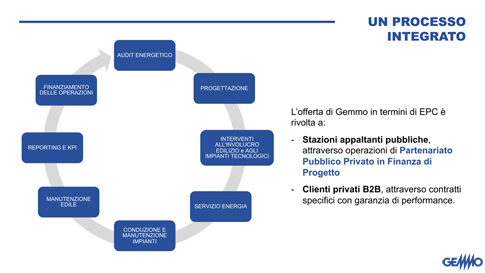
Gemmo’s focus on efficient energy management reflects the company’s commitment to sustainability as part of its corporate culture.
There was a time when the only lens through which the value of an enterprise was assessed was the economic lens. Turnover, its growth rate, or the frequency and conspicuousness of coupons issued to shareholders gave all the information analysts and investors could need. Today it is finally understood that businesses are not monads outside of space and time, but actors capable of affecting the environment and the social fabric, changing them for better or worse, and therefore should be evaluated with their systemic value in mind. This is an important development that excites us as citizens and as a business. This green turn, in fact, opens up great opportunities for a company like Gemmo that has been an ESCo (Energy Service Company) since 2012. That is, a company working in the field of energy saving and energy efficiency, which is ISO 50001 and UNI CEI 11352 certified.
It is a momentous paradigm shift, the result of a process that began decades ago and has not yet been accomplished, but which is seeing a further boost thanks in part to the National Recovery and Resilience Plan. The NRP, according to the latest draft dated Jan. 12, 2021, plans to allocate 68.9 billion, or 37 percent of the total, for the green revolution and ecological transition. Among the four lines of action identified for this macro-mission, one relates specifically to energy efficiency and building upgrading. This includes reducing the energy consumption of buildings that generate more than one-third of total consumption in Italy, as well as earthquake-resistant retrofitting of buildings. In fact, most of the country’s 14.5 million buildings were built in eras before the current regulations related to energy efficiency.
The roots of sustainability
In the field of sustainability, a very important concept is that of the Triple Bottom Line (Tbl), proposed in 1981 by Freer Spreckley and reworked in 1997 by John Elkington, in the book Cannibals with Forks. The former advocated the need to consider environmental and social benefits alongside economic ones when assessing the value of an enterprise to society. Elkington remarked that the Tbl approach is one that “leads companies to focus not only on economic value, but also on the environmental and social value they produce or destroy.”
This pattern, known as the 3Ps(Planet, People and Profit) model, reveals a company’s ability to meet the economic needs of ownership and stakeholders without the bill being paid by the community or the environment.
Making a business strategy one’s own that enables the company to be profitable, economically sound contribute positively to the respect of workers’ rights, community welfare and environmental protection always bears good fruit. And this is where Gemmo‘s best efforts go.

Making business strategies that look at energy saving and energy efficiency and contribute to the well-being of the community is the cultural revolution that Gemmo is leading.
Efficient energy management
Voluntarily adopting responsible behavior will enable you to respond appropriately to stakeholder demands by laying the foundation for the lasting development of your enterprise. In this context, talking about energy efficiency becomes relevant. Not least because energy is a permanent topic of discussion in the G8 and G20 international groups.
Energy efficiency means achieving the same or improved performance by consuming less energy and lowering the demand for sources such as oil, coal, natural gas, and electricity. If this paradigm were embraced on a large scale by businesses and in construction, a small revolution would take place because energy demand would drop dramatically. There would, therefore, also be an impact on the production and transportation of energy sources. This is no small matter. According to the U.S. Environment Protection Agency (Epa), the burning of coal, natural gas and oil to generate electricity and heat accounts for 25 percent of global greenhouse gas emissions. It is obvious that if consumption of the former decreased, the latter would also decrease.
In addition to the aspect of raising people’s awareness, it facilitates the transition to a renewable energy idea. The continued use of fossil fuels in the world has caused huge environmental problems and led to the evaluation of renewable energy sources, such as wind or solar. And here the Triple Bottom Line is a facilitator to accelerate the transition to a new energy matrix. The results of this transition, in fact, are reduced greenhouse gas emissions and reduced operational risks inherent in other energy sources such as nuclear power plants. Theuse of renewable energy sources is an irreversible trend that will continue to grow worldwide in the coming years.
This macro-environmental consequence would be followed by other microeconomic ones: a company that managed to save money on its energy bill would free up resources that can be more usefully invested elsewhere. For example, in new machinery or more up-to-date computer programs, hiring more staff or further qualifying their own.

The triple Bottom Line is an accelerator that pushes toward
a new energy matrix that produces in the immediate
savings and benefits to the environment and public health.
These are not insignificant figures. A British study commissioned by the British government in 2014 showed that a good energy efficiency program, in the corporate sector, would save up to 39 percent of utility bill spending, or 3.9 billion pounds. Savings on lighting alone, which is worth 20 percent of energy spending in industrial and commercial buildings, would save 1.1 billion pounds. A U.S. Department of Energy report last July estimated a savings of 25 percent on the average household’s energy consumption, which is around $2,200 a year.
In the United States, the government in 1992 launched the Energy Star initiative, promoting energy efficiency. This initiative saved Americans 430 billion kilowatt hours of electricity in 2018 alone, equivalent to $35 billion and 330 million cubic meters of greenhouse gas emissions.
Since 1992, 3.5 billion cubic meters of harmful gases have been saved, the equivalent of the pollution produced each year by 750 million cars.
Investing in energy efficiency
That in energy efficiency is an investment in every sense of the word: for an initial cost, there is a return in terms of reduced consumption, waste and thus energy expenditure. Not to mention acompany ‘s reputational gainin being perceived as a positive player by the community of the place in which it operates.
At Gemmo we do just that: we design, build, operate and maintain highly complex technological facilities in hospitals, business centers, and infrastructure such as railway stations, road tunnels and airports. And we always do so with an ameliorative or proactive approach, which means preferring overhaul interventions that lead to improved value and performance of an asset rather than intervening later with maintenance or replacement of the asset. For us, in fact,energy efficiency is not just a business area but a principle inherent in the company’s mission.
Believing in energy efficiency means investing in human capital, because making efficiency is a team effort that starts as early as the bidding and design phase. And Gemmo has in-house expertise to propose and implement efficiency projects: energy managers, BIM specialists, specialized bidding engineers, and a technical department that is constantly updated on the latest technologies.
We have also invested in technology, including software for BIM(building information modeling) and BEM(building energy modeling) for energy modeling of the building-plant system. By knowing the building and its usage data, energy performance can be calculated and possible improvements identified.
These efficiency-building processes have high costs, especially at a time when the global economy is suffering, with government funds stretched thin and private funds not helped by the credit crunch. That is why we have adopted some good practices already in use abroad, such as the project financing, a tool by which Gemmo bears part of the cost of building an asset and in return gets the management of it. From this perspective, an extra cost during construction can be seen as better future management.
This is what happens in our project financing hospital projects, which combine construction with energy management and maintenance. We can mention the Ospedale dell’Angelo in Mestre, the Niguarda in Milan, the Alto Vicentino Hospital in Santorso, and those in Cittadella and Camposampiero. Also, the SS. Giovanni e Paolo in Venice, the Monselice Hospital and the Bellaria Hospital in Bologna. These are all projects where energy management with an eye for resource optimization, efficiency and savings are the basis of every choice.

Through the EPC (energy performance contract) Gemmo carries out interventions.
of upgrading and improving the energy efficiency of facilities
and buildings by investing firsthand and ensuring energy savings
and reflex benefits on the environment and social fabric.
Efficient energy management projects
Today Gemmo is carrying out several Efficient energy management and energy saving projects: think of the multiservice maintenance contract for Intercent-ER, where we are in charge of more than 120 hospital buildings, but also the Aler Milano project, which involves the management of residential real estate with a view to energy efficiency and upgrading of︎ 42 thermal power plants in 96 buildings, for about 6,000 dwellings.
To conclude, a few numbers: thanks to the use of self-generation plants (cogeneration/regeneration) last year we installed and operated a capacity of 26 MW, and in 2019-2020 an average of 23,000 tCO2 and 6,100 TOE per year were saved.
This is the way we do our part, taking care of the environment and the people who live in it.
BOX | Services: Gemmo in energy efficiency
- Energy audit
- EPC – Energy Performance Contract
- Study of technical solutions to increase energy performance
- Using CMMS management information to track activities on the premises, faults, etc. and propose extraordinary and improvement maintenance
- Energy management
- White certificates
- Energy management systems

The efficiency processes followed by Gemmo invest
on capitalhuman and technology by combining construction,
energy management and maintenance in a futuristic way.
